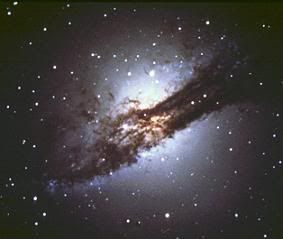|
|
Post by glactus on Oct 18, 2008 23:03:07 GMT
 Centaurus A (NGC 5128) is a lenticular galaxy about 14 million light-years away in the constellation of Centaurus. Magnitude is 7.8. It is one of the closest radio galaxies to Earth, so its active galactic nucleus has been extensively studied by professional astronomers. The galaxy is also the fifth brightest in the sky, making it an ideal amateur astronomy target, although the galaxy is only visible from low northern latitudes and the southern hemisphere. A relativistic jet which extracts energy from the vicinity of what is believed to be a supermassive black hole at the center of the galaxy is responsible for emissions in the X-ray and radio wavelengths. By taking radio observations of the jet separated by a decade, astronomers have determined that the inner parts of the jet are moving at about one half of the speed of light. X-rays are produced farther out as the jet collides with surrounding gases resulting in the creation of highly energetic particles. As observed in other starburst galaxies, a collision is responsible for the intense burst of star formation. Using the Spitzer Space Telescope scientists confirm that Centaurus A is going through a galaxy collision by devouring a spiral galaxy.  Credits: This is a NASA/Hubble image |
|